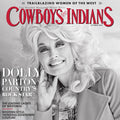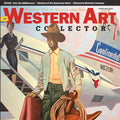Maynard Dixon, Western Art Collector 2007
By Medicine Man Gallery on
Maynard Dixon, Western Art Collector 2007

Maynard Dixon, Picacho Solito, Rio Arriba, New Mexico, (October 1931), oil on canvas board, 16 x 20”
Collecting Maynard Dixon
Reprinted courtesy of Western Art Collector, November 2007
Maynard Dixon expert Dr. Mark Sublette of Tucson’s Medicine Man Gallery talks about the mounting interest in the man he calls the Edward Hopper of the West.
Western Art Collector magazine recently spoke with Dr. Mark Sublette, a noted expert and owner of Mark Sublette Medicine Man Gallery about legendary landscape artist Maynard Dixon (1875-1946), whose work has been drawing considerable attention on the secondary market.
Western Art Collector: What draws you to Dixon’s work?
Mark Sublette: Dixon’s originality. Dixon’s painting style and honesty to subject matter draws me to his work. If you look at a Dixon painting and see a Native American, you know the dress and the surroundings Dixon painted them in was historically accurate. Unlike many contemporary artists of his time, Dixon was more concerned about capturing the “real moment” than some “romanticized” image. He understood his paintings would be testimonies to the West and its people— he saw and recorded these images.
My overwhelming interest began when I moved to Tucson during my medical residency. The initial attraction for me was being in a city where Dixon lived and captured the same things that moved me. Then, because I collected Native American art, I was even more intrigued by the fact that Dixon always got it right—he didn’t romanticize what would sell, he just told the story. He put the right pots with the correct tribes, and the right beadwork with the right groups.

Maynard Dixon, Lone Pine, California, (c. 1919), oil on canvas board, 15 1/2 x 20”
Western: Let’s talk about what makes Dixon so important for collectors right now.
Sublette: Dixon has always been collected and admired, but with regard to the present moment, there is still a small window, perhaps two years, in which one can afford to acquire a fairly important work. Dixon’s popularity is growing daily and this article testifies to that interest. The time to collect is now, as there are still some very good examples to choose from.
Western: What do you see ahead in terms of the market for Maynard Dixon paintings?
Sublette: The market has definitely not peaked. I’m afraid within three years, however, all the oil paintings will be selling for over $100,000 which makes collecting for most difficult. Today you can still find a nice small example (6 x 8”) for $55,000 to $85,000 and nice drawings in the $5,000 to $10,000 range and occasionally less.
Western: What’s your advice to someone wanting to collect a Dixon at this point?
Sublette: Figure out the most you can afford to spend and then add fifteen percent You will be better off in the long run to buy the most expensive piece because soon you won’t be able to. Look to the leaders in the field as they are the most likely to have the material and understand the market. If you purchase at auction, make sure you talk to their specialists and also consult the leading dealers in Dixon to make sure this piece fits with your collection and has no condition problems. It is not unusual to see Dixon fakes come out on the market — this happens when an artist becomes increasingly valuable. As a leader in the field, I see most of the Dixon pieces that hit the market and unfortunately have seen an increase in the number of fraudulent works. Most of these are usually drawings and watercolors.

Maynard Dixon, Tobins Camp, Pinion Valley, Nevada, (July 1927), pen and ink on paper, 9 x 15”
Western: How, in your opinion, can collectors check authenticity?
Sublette: Be wary of online auctions unless they offer an ironclad guarantee and written authentication, as they seem to be the number one outlet for fraudulent works. If you are looking at an oil, make sure it is going to be in the upcoming Dixon Catalog Raissonné, you will want to have this done to insure authentication.
Western: Please give collectors an idea of how Dixon’s work has been valued over the years. What did his paintings sell for while he was alive and how have those prices changed at periodic junctures since then?
Sublette: Dixon’s original catalog had most of his paintings listed by name, size, and value. His most important work sold for $2,500. A nice 16 x 20” would sell between $300 to $600. This same 16 x 20” size now sells for $150,000 to $200,000 and up. Ten years ago, these same paintings were selling for $35,000 and five years from now they will probably be selling upwards of $500,000 for a great example. Dixon’s greatest works originally sold for $2,500 and could easily bring up to $2,000,000 in today’s market.

Maynard Dixon, Old China Town, (September 1937), oil on canvas board, 16 x 20”
Western: Talk about Dixon’s place historically in the final analysis of Western art and landscapes.
Sublette: Dixon has, and always will be, an original voice for all of us who live and love the West. He was there when portions of the West were still Territories and the land untamed. He lived and captured the essence of young cities such as Tucson, Arizona when it just a little cow town. Tucson now has over a million people and thanks to Maynard Dixon one can look back to these images for a glimpse of our past. Dixon, in my opinion, is considered one of the greatest painters of the West that ever lived. He is the Edward Hopper of the West.
Where To See Maynard Dixon Works:
The Tucson Maynard Dixon Museum (maynarddixon.org) is located inside Mark Sublette Medicine Man Gallery, and is dedicated to the life work of Maynard Dixon.
The Tucson Art Museum will host a special Maynard Dixon exhibit from October 2008 through February 2009. The exhibit will house more than one hundred Dixon works.
The Maynard Dixon Catalog Raisonné is being compiled by Donald J. Hagerty, author of Desert Dreams the Art and Life of Maynard Dixon.

Maynard Dixon, Old Patio, New Mexico, (September 1931), oil on canvas board, 16 x 20”



